Waters HPLC 4
| Objektnummer | B00011220 |
|---|---|
| Numéro d'identification | 011220 |
| Nom de l'objet | Waters HPLC 4 |
| Statut | Stock unit |
Groupe de produits: Systèmes CLHP
Statut, conditions de livraison et de paiement
Vérification des appareils
Les appareils d’occasion sont vérifiés par Labexchange Service GmbH avant la livraison. Vous recevez des appareils entièrement fonctionnels.
Délai d'expédition
Les délais de livraison indiqués sont les plus rapides pour l’article en cause. Les délais de fait peuvent varier au cas par cas. Les délais de livraison définitifs sont indiqués dans la confirmation de commande.
Nous offrons des livraisons collectives par principe. Le délai de livraison s’oriente à l’article avec le délai de livraison le plus long. Une livraison partielle est possible par prix additionnel.
Méthodes d'expédition
Courrier, agences d'expédition, autocueillette, livraison par flotte de Labexchange
Conditions de livraison
Prix plus frais d’expédition. Les frais d’expédition indiqués sont à prévoir. Dérogations éventuelles sont possibles.
Si les coûts de transport ne sont pas spécifiés, s'il vous plaît demander séparément les frais de transport. Les frais de transport et d'emballage indiqués se réfèrent à l'itinéraire de transport le moins cher et sont sujets à des augmentations de coûts imprévues. En raison d'événements imprévisibles, les tarifs de transport et les délais de livraison peuvent changer à tout moment et doivent être adaptés à la situation actuelle. Incoterm codage selon les Incoterms 2010: Pour personnes qui viennent chercher les dispositifs elles-mêmes: EXW, pour les expéditions par voie maritime: CFR, par avion: CPT, d'autres expéditions: DAP. Remarque: Nous n'établissons pas des preuves préférentielles/EUR1. Dans le cas d’un enlèvement par vos soins/EXW de pays à l’intérieur ou à l’extérieur de la Union européenne, nous devons conserver 16% de TVA d’acheteur comme dépôt de garantie, jusqu’à ce que nous ayons reçu l’attestation de reception/la prevue de livraison.
Modalités de paiement
Nous n’acceptons pas le paiement par lettre de credit, PayPal, etc. Dans tous les cas le montant est payable sans déduction. Jusqu’au paiement complèt l’équipement reste notre propriété. Un escompte n’est pas accordé.
|
Pays |
Modalités de paiement possible |
Remarque |
|
DE, AT, CH |
Paiement par facture, prépaiement, par carte de credit |
Paiement par facture est possible pour clients professionnels. |
|
NL, BE, LU |
Paiement par facture, prépaiement, par carte de credit |
Paiement par facture est possible pour clients professionnels. |
|
Autre pays |
Prépaiement, par carte de credit |
|
Nos conditions de vente, de livraison et de paiement sont en vigueur. Vous pouvez télécharger les documents ici.
La vente intermédiaire nous est réservée.
Défintion des statuts
Tous articles sont d’occasion, sauf si explicitement défini comme « appareil neuf ».
|
Statut |
Condition |
Remarque |
|
Immédiatement disponible |
Occasion |
L’article a été déjà entièrement vérifié et peut être envoyé directement à vous. |
| En stock |
Occasion |
L'article est en notre stock, mais doit être vérifié avant la livraison par nos techniciens Vous recevez des articles entièrement fonctionnels. |
|
Publié |
Occasion |
L’article est toujours au l’offreur. Nous achetons, vérifions et en fin livrons l’article après votre commande. Le certificat de fonctionnement ainsi que le rapport de service sont inclus à la livraison. |
|
Appareil neuf |
Neuf |
C’est un dispositif neuf. L’article n’est pas utilisé et neuf d’usine. En ce qui concerne des article neufs, la garantie du fabricant est valable. |
|
Labprocure |
Occasion |
Responsable du contenu de l‘offre d’appareil est la société Labprocure GmbH, comme annonceur. Labprocure assume la responsabilité des offres annoncées ici ainsi que des photos et des textes d’offre inclus. Labprocure GmbH, Bruckstraße 58, 72393 Burladingen. |
Firma: Waters
The following illustrations and descriptions are referring to the instrument model and are drawn from brochures. They are not representating the delivery volume. The exact delivery content you will find only in the offering text.
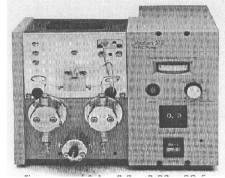
Precise, reliable performance with Waters 510 HPLC Pump
The Waters 510 Pump is a high-precision HPLC pump that combines the most important aspects of performance-high precision, reliability, smooth solvent delivery, and proven performance. The 510 is the industry standard for microbore to semipreparative chromatography. The simple yet dependable design consists of dual reciprocating pistons driven by stepper-motor controlled, noncircular gears for smooth, precise delivery.
Dependable design ensures accuracy
The 510's standard flow range of 0.1 to 9.9 ml/min can be externally controlled down to 0.001 ml/min. and can operate in fully-automated isocratic mode, gradient mode, or flow programming mode. The 510's compressibility compensation circuitry automatically adjusts the motor's speed in response to changes in operating pressure, guaranteeing accurate flow delivery under all operating conditions and with all mobile phases.
The 6000 psig operating pressure lets you take advantage of the speed and efficiency of all microparticulate columns. An automatic high pressure shut off mechanism protects your columns. The mechanically activated outlet check valve and real design gives greater reliability under any operating conditions, even when using volatile solvents such as hexane und methylene chloride. Advanced seal material and mechanical design aid in precise solvent delivery und significantly extend the life of the pump. A Plunger Wash Kit is also available to extend the life of the seals when performing buffered mobile phase applications.
Drive: Positive gear drive with precision stepper-motor (12 steps/µl)
Flow Rate: 0.1 to 9.9 ml/min
with 680 Autornatic Gradient Controller 0.01 to 10.0 ml/min
with Micro Flow Control Module 0.001 to 9.9 ml/min
with 510 EF (Extended Flow) 0.22 to 22.5 ml/min
Flow Rate Precision: ±0.1 % of setting
Flow Rate Accuracy: ±1.0% of setting or 0.005 ml/min
Maximum Pressure Limit: 6000 psig (410 bars)
Pressure Meter Range: 0 to 6000 psig (0 to 410 bars)
Overpressure Limits: Continuously adjustable between 100 and 6000 psig (7 and 410 bars)
Piston Displacement Volume: 100 µI each piston (225 µI for extended flow
CHM
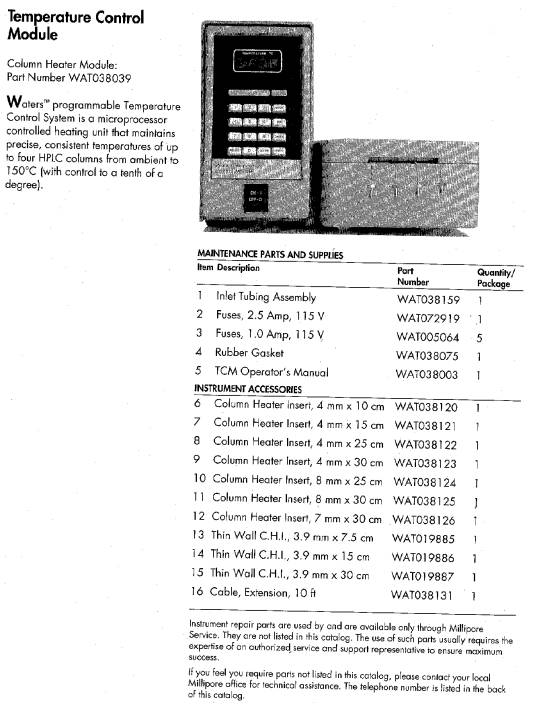
TCM
FEATURES
The WatersTM Temperature Control System (Figure 1-1) consists of the Temperature Control Module (TCM) and one or more column heaters. The System provides stable operating temperatures for columns and insulates them from changes in ambient temperature.
The TCM is an independent, microprocessor-controlled unit capable of simultaneously regulating the temperature of up to three column heaters. Each heater may be Set to a different temperature. An audible alarm sounds if either the upper or lower temperature limit is exceeded.
Either unit may also be purchased separately from the System. Each heater supports up to four columns within tailored aluminum inserts. A high reliability circuit (independent of the TCM) protects the columns in the unlikely event of an electronic component failure.
Theory of Operation
A programmed microprocessor serves as the control element in the TCM. The program provides a coupled data feedback control system in which the difference between the temperature entered into the memory and the actual measured temperature determines the rate at which the TCM reaches the desired temperature. The interval of time in which the heater is actively heating is referred to as the duty cycle.
The feedback control system measures both the magnitude and the integral of the difference between the set temperature and the actual temperature, then converts these measurements into a time modulated signal. These two measurements are alternately known as proportional control and lag compensation.'
The green indicator Iight on the heater illuminates only when power is applied to its heating element (it does not indicate that ac power is on). The light remains on for briefer periods of time as the heater temperature approaches the value programmed into the TCM.
This feedback system allows rapid warmup and stabilization of the system while minimizing the possibility of a temperature overshoot. The microprocessor control also contains a feedforward compensation to accommodate fluctuations in the power line voltage.
Technical Data
Temperature Control Module
Power consumption Nominal 20 VA
Programmable temperature limits 0-150°C (32-302°F)
Environmental data Ambient temperature: 10° to 40°C
Storage temperature: -40° to +75°C
Humidity: 10% to 90%
Safety features Audible alarm/Indicator
Grounding
Single or dual line fuse
Over/under temperature alert
Dimensions Height: 9.12 inches (23.18 cm)
Length: 14.5 inches (36.83 cm)
Width: 5.0 inches (12.5 cm)
Operating temperature range Ambient: -150°C
Temperature stability ±0.1 °C (in an equilibrated steady state)
Day-to-day repeatability ±0.1 °C (under the same analysis conditions)
Stabilizing time 10 min to 30 min is typical (depending on the number and type columns used)
Detector 490
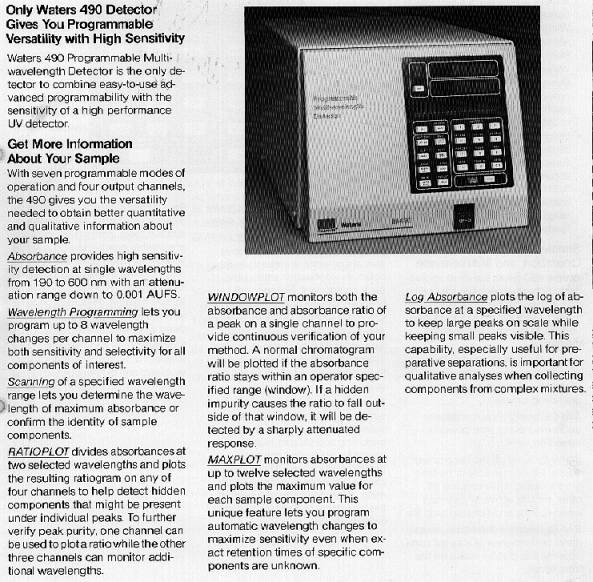
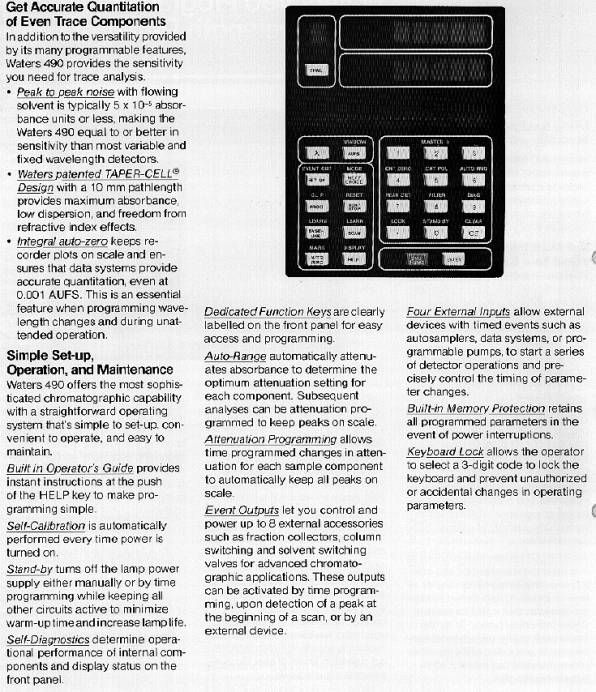
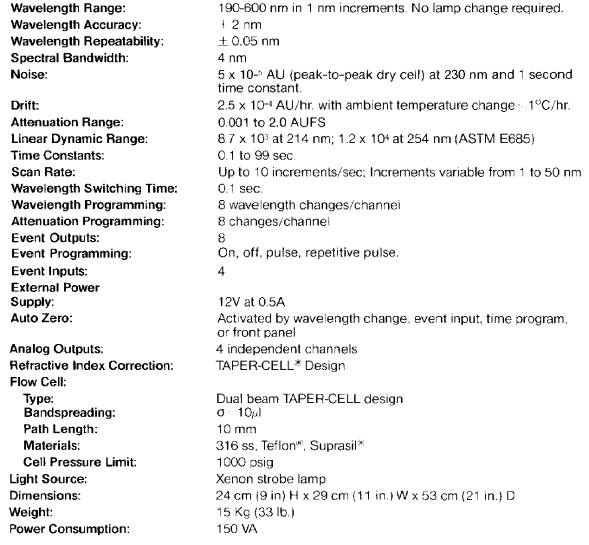
WISP 712
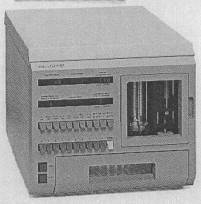
The 712 WISP combines precision and reliability to offer you an autosampler with exceptional value and versatility. As a standalone module, the 712 WISP provides more capabilities than other autoinjectors in its price range. Used in a Waters Powerline HPLC System (or a Waters data controlled system) it gives you added automation and enhanced documentation of system information.
The 712 allows you to program an entire carousel of samples with easy-to-use individual vial programming features:
LED display: Confirm injection parameters of set-up or during run. Injection volume: Program individual vials from 1 µl to 2000µl in 1 µl increments. Sample number: Go directly to specified sample for stat operation or to change any individual sample parameters.
Analysis time: Select sample analysis times from 1 minute to 9 hours, 59 minutes, in 1 minute increments.
Number of injections per vial: Program each sample for 1 to 9 injections. Equilibration delay: Program injection times from 1 minute to 9 hours, 59 minutes in 1 minute increments, for column reequilibration, automatic methods switching or integrator delay (useful during gradient elution chromatography).
System command: Program special routines such as standard/sample, syringe overdrawn, auto purge. Also communicates system or program errors to maximize productivity.
Specifications/Features
|
|
712 WISP |
|
Typical Precision |
< 1.0% RSD |
|
Linearity (1-100µl) |
> 0.99 |
|
Carryover |
< 0.1% |
|
Sample Waste (per inj.) |
None |
|
Minimum sample required (for 1µl inj.) |
7µls |
|
Random Access Programming |
No |
|
Injection Range |
1-2000µls |
|
Replicate Injections (per vial) |
1-9 |
|
Front Panel Control |
Yes |
|
Display Type |
Multisegment LED's |
|
Sample Carousel(s) |
4ml - 48 vial 1 ml - 96 vial |
|
External Event Contact |
|
|
Closures |
4 |
|
Non-Programmable |
4 |
|
Programmable |
0 |
|
Communications |
|
|
Output |
BCD |
|
Input/Output |
INTELINK, IEEE-488 |
|
Sample Compartment |
|
|
Temperature Control |
4°C-Ambient |
|
Advanced Sampling Routines |
|
|
Priority Samples |
No |
|
Auto Standards |
Yes |
|
Auto Addition |
No |
|
Auto Transfer |
No |
|
Advanced Sample Preparation |
|
|
Capabilities |
|
|
Filtration |
No |
|
Solid Phase Extraction |
No |
|
Serial Dilution |
No |
|
Mixing |
No |
|
Liquid/Liquid Extraction |
No |
|
Evaporation |
No |
|
Trace Enrichment |
No |
|
Power Requirement |
110-220V; 50-60Hz 35psi air |
Detector 460
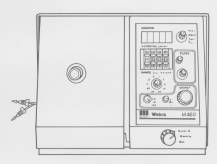
The Waters 460 Electrochemical Detector (referred to as the Waters 460) is designed for applications involving liquid chromatography with electrochemical detection (LCEC). The Waters 460 employs a three-electrode amperometric cell for high stability and sensitivity with Iow noise.
The unique cell design of the Waters 460 allows Operation at picogram levels per single injection. The working electrode is encased in borosilicate glass for Iow noise and easy maintenance. A flow through diaphragm in the reference electrode ensures that bubbles are flushed out of the cell. The front panel cell cover is a Faraday cage, which protects the analytical cell from outside interferences.
The Waters 460 contains the following features:
a unique, Iow-noise electronic design;
a 2.5 µl cell to minimize band broadening while maintaining peak resolution; and
a noise filter with 8 settings for Optimum signal-to-noise ratio.
In addition, the analytical cell is designed for ease of maintenance and can withstand a maximum pressure of 150 psi (10 bars). The Waters 460 can be operated upstream of another detector when running two detectors in series.
Specifications
Environmental Operating temperature: 10 to 40°C
Storage temperature: 2 to 50°C
Sensitivity (for 10 mV recorder) 0.02 nAFS maximum
20.0 nAFS minimum
Potential accuracy (between reference ± 1% of setting (± 2 mV)
and working electrodes)
Maximum potential difference between 2 V
auxiliary and working electrodes
Electrical output signals Recorder: 0 - 10 mV (output impedance: 49.5 0) Integrator: 0 - 1 V (output impedance: 400 S2)
Gell volume 2.5 µl; 50 µl gasket
Total swept volume 12 µl
Maximum pressure 150 psi (10 bars)
Wetted materials Stainless steel, Teflon, quartz, glassy carbon, borosilicate glass
Hitachi D-7500
Power Supply and External Dimensions
a. Power supply and consumption 100 ~ 240 V AC
b. Operating temperature 10 ~ 35 °C
c. Humidity R.H. 45 ~ 85 %
d. External dimensions Width: 405 mm
Depth: 445 mm
Height: 160 mm
e. Weight About 8 kg
Input
a. Input signal Digital input: 2
Analog input: 1 (2 at option)
b. Number of simultaneous
processing channels 2
c. Integration range 1 ~ 10 9 µV sec
d. Pulse height range 1 ~ 10 6 µV
e. Linearity ± 0.1 %
f. Sampling period 50, 100, 200, 400, 800, 1600, 3200, ms
Analog input
a Input voltage -10 mV ~ 1 V
b Input impedance 10 MΩ
Storage
a. Storage time About 20 hours at sampling period 800 ms
About 3.5 hours at sampling period 400 ms
b. Number of storable chromatograms About 40
30-minute chromatograms at sampling period 800 ms
c. Number of peaks for concentration
calculation About 24,000
d. Marker signal input time 300 max. (marker can be superimposed on chromatogram for 1 channel only)
Waveform Processing
a. Method of waveform processing Automatic or parameter setting
b. Peak processing on tailing Automatic or parameter setting
c. Peak processing on leading Parameter setting
Identification of Peak
Absolute or relative retention time method
1 Identification windth Percentage or absolute time method
2 Number of identifiable peaks Up to 250
Calculation
a. Quantitative calculation 1. Simple percentage method
2. Peracent normalization method
3. Internal standard method
4. Absolute calibration curve method (extemal stan- dard method)
5. Exponential calculation
b. Other calculations 1. Grouping Up to 30 peaks
2. Multi-data Up to 30 peaks
3. Multi-file Up to 30 peaks
4. Averaging
5. Background subtract
6. Slice data
7. Data diagnosis
8. Relative standard deviation (Up to 5 data)
c. Calibration 1. Average of several standard measurements
2. 1 to 8-level calibration curve (graph display possi- ble)
3. Automatic correction of retention time
4. Cancellation of unsatisfactory analysis
Recording
a. Recording system Ink jet printer/plotter
b. Recording chart Z-fold chart
Width 239 mm, length 279 mm/page (11 inch)
Width 239 mm, length 305 mm/page (12 inch)
Width 239 mm, length 297 mm/page (A4)
c. Chart speed Up to 60 mm/min (1.25, 2.5, 5, 10, 20, 40, 60 mm/min)
d. Pen speed 60 characters/sec
e. Number of retention time digits 5 (600.00 min) or 6 (600.000 min) selectable
f. Number of peak area digits 9 (999,999,999 µV s)
g. Number of peak height digitis 6 (999,999 µV)
h. Number of concentration digits 7 (8000.000%)
i. Chromatogram recording Unrestricted
j. Chart rewinding up to 500 mm
Time Program Controllable according to time designation
25 steps programmable in combination of 16 functions
1. INTEG INHIB
2. PLOT ATT
3. PLOT ON/OFF
4. CHART SPEED
5. MANUAL
6. SENS
7. VERT
8. TAIL
9. LEAD
10. N-METH
11. F-HORIZ
12. B-HORIZ
13. NEG-PK
14. AUTO-Z
15. GROUP
16. OFFSET
Various Tables
a. Component table 16 tables can be generated \
b. Link table Up to 9 links (1 ~ 9) possible - Backed up by battery
c. Comment table Contains 5 lines of 30 characters each/
d. Sample table Contains up to 200 samples
Number of Files 9 storage files
2 standard files (for GC and LC)
Chromatogram Overlay Up to 5 chromatograms
(but calculation result is not printed, and only rere cording possible)
Communication
a. RS-232C
① Connection terminal RDED-9PE
② Sync system Asynchronous serial transfer
③ Communication system Full duplex (bidirectional communication possible)
④ Input/output level RS-232C input/output
⑤ Communication bit format ① 8 data bits + 2 stop bits
② 7 data bits + 1 even parity bit + 2 stop bits
⑥ Baund rate 2400, 1200, 600, 300, 150, 75 bps, selectable by DIP switch
b. D-Iine
① Baund rate 19200 bps
② Contacts START, ERROR STOP, BUSY
Options
a. 2-channel analog input device
① 2-channel analog input
② Fraction marker input contact
③ Contacts (1 ch START IN and BUSY OUT,
2ch START IN and BUSY OUT)
b. 3.5-inch floppy disk drive One drive unit
① Raw data 80 chromatograms/FD (Approx. 110 hours/FD)
② Reduced data 80 data items/FD (78000 peaks/FD)
③ File 80 files/FD
c. Stacker/stand set








